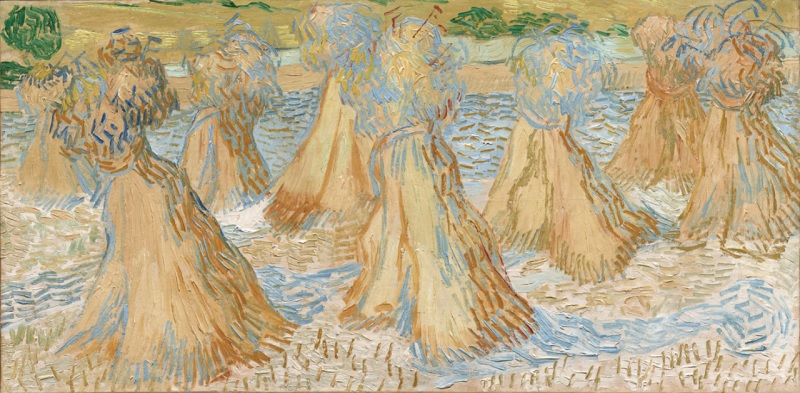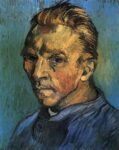
Vincent Van Gogh
Dutch, 1853–1890 (active France)
Sheaves of Wheat, 1890
oil on canvas
20 × 40 in.
Dallas Museum of Art, The Wendy and Emery Reves Collection

Van Gogh - Self-Portrait, September 1889
“For my part, I’m wholly absorbed in the vast expanse of wheatfields against the hills, large as a sea, delicate yellow, delicate pale green, delicate purple of a ploughed and weeded piece of land, regularly speckled with the green of flowering potato plants…”
– Letter to Theo, 14 July 1890
COMMENTS
On 17 June 1890, Vincent van Gogh received a large shipment of canvases from his brother Théo. He had been in the small town of Auvers-sur-Oise since 20 May, remaining under the care of the homeopathic physician, Dr. Paul Gachet. Although plagued with physical and psychological problems, van Gogh continued to produce works at a fantastic rate. From the time that the shipment of canvases arrived until his suicide at the end of July, van Gogh painted thirteen large canvases of a double-square format. These works are unique in his career for their format and for the fact that they seem to be a series. All but one of the double-square canvases were painted with horizontal landscapes (the thirteenth is a vertical portrait of Mlle. Gachet at the piano, Kunstmuseum, Basel).
From the evidence of its subject, the Reves "Sheaves of Wheat" is among the latest of this group. The wheat harvest in the region of Vexin, in which van Gogh painted, occurs from mid- to late July, and earlier that summer van Gogh had painted a field of ripe wheat on the verge of harvest, in his famous "Crows over the Wheat Field" (Rijksmuseum Vincent van Gogh, Amsterdam). The Reves painting seems to have been made as part of a sequence of canvases detailing the wheat harvest, beginning with "Wheat Field under Cloudy Sky" (Rijksmuseum Vincent van Gogh), progressing to "Crows over the Wheat Field" and "Sheaves of Wheat," and concluding with "Field with Haystacks" (private collection).
"Sheaves of Wheat" focuses intently on the interrelationship of eight sheaves viewed close at hand. Rather than looking over a distant field, as is usually the case with harvest landscapes, the viewer is immersed in the field, almost as if to approximate a worker's perspective. The sheaves themselves are immediate and palpable, and we are encouraged to think of them as being freshly cut, to revel in the scent of ripe wheat. As if to emphasize this element of sensual fecundity, van Gogh bathed the entire work in yellow light, lighting yellow with yellow. The distant sky seems filled by the sunlight at the day's very end. This effect of yellowness is emphasized by van Gogh's use of the precise color-opposite of yellow - an intense lavender - for shadows and for the earth in the adjacent field. Van Gogh's painting of sheaves conveys the sense of a group or family portrait. Each bundle of wheat bends, distributing its weight in an individual way; each appears to nod or pose for the painter. This individuality clearly contrasts with the collectivity of the wheat field from which they are cut, and from the domestic unit of the haystack (almost like a loaf of country bread), which replaces them.
Interestingly, Pissarro, who had lived in nearby Pontoise a decade earlier and helped arrange van Gogh's stay with Dr. Gachet, painted these fields during the grain harvest almost twenty years before. Daubigny, whose house van Gogh painted twice, at the same time and in the same format as the "Sheaves of Wheat," had worked in these fields before his death in 1878.
The universal symbol of the grain harvest has appealed to landscape painters throughout the history of the genre, but no artist ever achieved a "group portrait" of wheat sheaves that can match van Gogh's late masterpiece in intensity and quality. Like all the other double-square canvases, it remains unsigned. No signature was necessary. It is tempting to conclude that these last paintings were conceived as a decorative ensemble. Van Gogh might have intended them - or some of them - for the salon or dining room of his patron and physician, Dr. Gachet, as Pissarro's 1873-1874 series of similar harvest pictures had decorated the dining room of the great collector, Achille Arosa. Sadly, van Gogh died before clarifying their collective aim, and, like the works intended to be grouped in specific rooms in van Gogh's house in Arles, the canvases from this set have been scattered around the world.
- Dallas Museum of Art, 2021
https://collections.dma.org/artwork/4193312
SBMA CURATORIAL LABELS
This landscape was made in the last month of Van Gogh’s life, during the wheat harvest in the fields around Auvers-sur-Oise. Van Gogh had agreed to return north to Auvers, just outside of Paris, to be treated by Dr. Paul Gachet, a doctor recommended by his friend, the artist Camille Pissarro. Gachet, himself an aspiring artist, befriended Vincent, and his home and family provided some of the last subjects for Van Gogh’s art.
Van Gogh made thirteen of these so-called double squares, a format that was preferred by Van Gogh’s artist-hero, the plein-air painter, François Daubigny, who lived and died in Auvers. The close perspective on the sheaves of wheat, combined with the high horizon and calligraphic, repeated dashes of pure pigment are signs of Van Gogh’s complete assimilation of the vocabulary of Japanese woodblock prints. However, the thickness of the paint application, at times enough to create cast shadows, is entirely alien to a Japanese aesthetic. No matter how near or far we are to the painted surface, its patterning retains its representational legibility, even though we are conscious of the decorative repeated dashes of which the entire canvas is made up. The overall visual interest and invitation to close viewing is akin to that of the woodcut illustrations that Vincent admired, whether from the pages of illustrated magazines like The Graphic or his favorite Dickens’ novels. In the 20th century, this unique quality of Van Gogh’s mature style would become the most emulated and hardest to imitate aspect of his art.
- Through Vincent's Eyes, 2022
